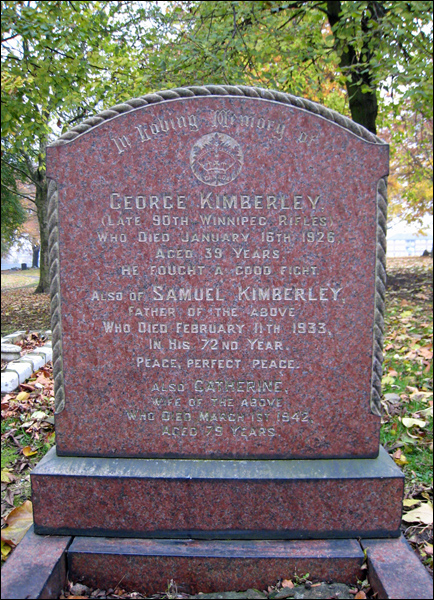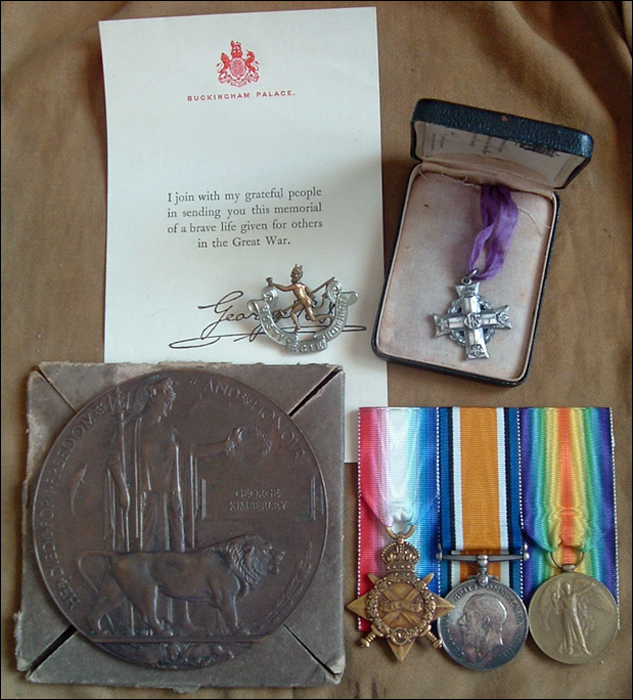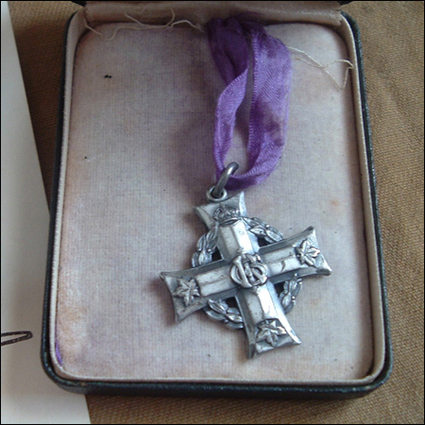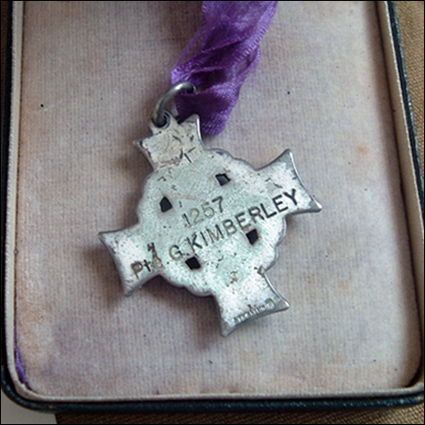Tipton
Remembers
Private 1257 George Kimberley

Photograph of medals at bottom of page.
Died Home on Friday, 16th January 1926, age 38.
Buried in Grave B.4. at Tipton Cemetery, Staffordshire, United Kingdom.
8th Bn., Canadian Infantry (90th Winnipeg Rifles).
Son of Mr Samuel & Mrs Catherine Kimberley, of 26, Neptune Street, Tipton, Staffs.
Born: Tipton, Enlisted: Valcartier, Canada, Resident: Unknown.
First landed France & Flanders, 13th February 1915.
Medal entitlement: 1914-15 Star, British War Medal, Victory Medal.
Soldier's Papers at National Archives survived and transcribed.
Not commemorated on any Tipton memorial.
Commemorated here because his grave was found in Tipton Cemetery.
Genealogical Data
1891 Census
5 High Street, Tipton Green, Tipton, Staffs.
Samuel Kimberley (29, Chain maker, born Sedgley), his wife Catherine (28, born Tipton), and their 3 children: Elijah (6, Scholar, born Tipton), George (4, Scholar, born Tipton), and Elizabeth (2, born Tipton).
1901 Census
5 High Street, Tipton, Staffs.
Samuel Kimberley (39, Chain maker, born Sedgley), his wife Catherine (38, born Tipton), and their 7 children: George (14, Labourer - General, born Tipton), Lizzie (11, born Tipton), Edward (9, born Tipton), James (9, born Tipton), Dora (4, born Tipton), Eva (2, born Tipton), and Benjamin Elijah (4 months, born Tipton).
1911 Census
5 High Street, Tipton, Staffs.
Samuel Kimberley (49, Chainsmith, born Sedgley), his wife Catherine (48, born Tipton), and 7 of their 9 surviving children of 10: Edward (19, Iron Founder, born Tipton), James (18, Labourer, born Tipton), Dora (14, born Tipton), Eva (12, School, born Tipton), Elijah (10, School, born Tipton), Louisa (8, born Tipton), and Conrad (5, born Tipton).
George was not living at his parent's home as he had emigrated to Canada in 1910.
Personal Data
George was born in Tipton on 25th January 1887, the first child of Samuel and Catherine Kimberley; the family were long-time residents at 5 High Street, Tipton Green. George emigrated to Canada in May 1910. Travelling alone, he left Glasgow on the SS Grampian heading to Quebec. The Grampian was an unlucky ship, built in 1907, it hit an iceberg in 1917 resulting in 2 crew being killed, and during a re-fit in Antwerp in 1921 caught fire and never sailed again, being scrapped in 1925.
On 27th August 1914, George enlisted in the Canadian Expeditionary Force at Valcartier, near Quebec. His occupation was given as chain maker, and next of kin Mrs Kimberley of 26 Neptune Street, Tipton. George was 5ft 6½ in tall with a 36½-inch chest, fair complexion, hazel eyes, light brown hair and was still a single man. He had a 1-inch scar on his back, vaccination marks on left arm, and small tattoo marks on right forearm. He gave his religion as Church of England. He had no previous military experience but became Private 1257 George Kimberley, of the 8th Canadian Infantry (Winnipeg) Battalion.
In late September 1914, the troopship S.S. Franconia sailed from Quebec with George on board, bound for England. The crossing took about 21 days, and after landing at Plymouth, the Canadians were sent to Salisbury Plain for training.
On the 21st November George had the first of a number of disciplinary indiscretions when he was stopped 3 days pay for being ‘Absent without leave’ – possibly a visit home to Tipton? On the 6th February 1915 George was given 1 day Field Punishment No. 1 for “Insubordination” and on the 29th March it was 25 days Field Punishment No.1 for being ‘Drunk falling in for parade’.
The battalion moved to France on 1st April 1915 and within 4 weeks the 8th Canadian Battalion was involved in the 2nd Battle of Ypres. Here, at St. Julien, the Canadians stood firm in the face of German gas attacks whilst the French colonial ‘Zouave’ troops were retreating in disarray. Without the Canadian’s stand at St. Julien, Ypres may well have fallen to the Germans with untold consequences.
It was at St. Julien that George was first wounded and subsequently admitted to Rouen No. 8 General Hospital with Gun Shot Wounds to his head and left shoulder. This was followed by a spell in Convalescent Camp before returning to his unit on 20th June 1915.
The spell away had not mellowed George, as on the 4th July he was ‘Drunk on active service’, this time receiving 21 days Field Punishment No.1. In the latter part of 1915 George suffered with ear trouble and then ‘trench fever’, leading to further spells in hospital. The year rounded off with a 5-dollar fine and 10 days Field Punishment No. 1 for being ‘Drunk in barracks’.
The early part of 1916 seemed a relatively quiet time for George, just one day ‘Absent without leave’ in February. June 1916, however, would change George’s life forever.
Action resulting in his death
On 2nd June 1916 the Germans mounted an attack to dislodge the Canadians from their positions around Mount Sorrel, just south-east of Ypres. In the fiercest bombardment yet experienced by Canadian troops, whole sections of trench were obliterated and the defending troops devastated. Human bodies and even the trees of Sanctuary Wood were hurled into the air by the explosions. The Canadians were literally blown from their positions and overwhelmed by enemy infantry.
Luck was not with George; on 4th June 1916 he received a very severe Gun Shot Wound to the head with multiple fractures of his skull. George was taken to Camiers No. 4 General Hospital. The wound affected his speech, his memory, the sight in his right eye and he lost part of his skull. He was at first recorded as being seriously ill and then dangerously ill, George was not expected to survive and visitors were to be allowed.
However, George was made of stern stuff and after 2 weeks had begun to improve and was transferred back to England, arriving at the East General Hospital in Cambridge on 24th June 1916. Three months later, after surgical treatment and some degree of recovery, George was sent to Woodcote Park Convalescent Hospital, Epsom for further treatment and assessment.
On 1st November 1916 a “Medical Report on an Invalid” was prepared on George’s condition - it was not good news. “Gunshot wound 3 inches x 1½ inches in left Parieto-Occipital region (the rear half of the skull), which pulsates. Slight purulent discharge. Complains of pain at site of wound. Headache, dizziness. Total right-sided blindness, speech is now alright except when greatly excited.” Not surprisingly, George was discharged on 13th December 1916 “being no longer physically fit for war service.”
George returned to Tipton to live with his parents. He was well known in Tipton, one of the many men who carried the physical scars of their time in the trenches.
We cannot begin to understand the pain that George suffered over the next 10 years, and the Tipton Herald of 24th January 1926 reported his death after he drowned in the canal. At his inquest, some 7 years after the end of the Great War, the Coroner still returned a verdict of "Death from misadventure, consequent from injuries he received in the Great War".
George was buried in Tipton Cemetery; he is not remembered by the Commonwealth War Graves Commission as his death was after the 31st August 1921 cut-off point for commemoration.
Newspaper Cuttings
Tipton Herald 24th January 1926
EX-SOLDIER'S DEATH
MR WC Checkley, Coroner, held an inquest at the Rising Sun, Toll End, on Monday evening, touching the death of George Kimberley, aged 38, who lived with his parents in Neptune Street. Deceased was well known amongst ex-Service men and others because of the terrible injuries he received in the Great War. Part of his skull was blown away causing him to wear a silver plate. He was also blind in his left eye. On Thursday morning last week, at 6.30pm, a boy named George Law of 300 Dudley Port saw the deceased run up the Navigation Bridge and then down the path to the canal. He shortly after heard a shout and a splash. He was frightened and ran away, but information was given to the police. The canal was dragged from that time until Saturday morning, when the body was recovered by PC Smith and Mr Joe Aston. Mr JH Stockdale, watched the interests of the family, and Sergeant Davidson was in charge of the enquiry. The Coroner returned a verdict of "Death from misadventure, consequent from injuries he received in the Great War".
England and Wales, National Probate Calendar (Index of Wills and Administrations) 1926.
KIMBERLEY George of 26 Neptune Street Tipton Staffordshire died on or between 14 January 1926 and 16 January 1926 in the Birmingham Canal near Navigation Bridge West Tipton Staffordshire.
Administration Lichfield 20 October to Samuel Kimberley chain smith. Effects £212 15s 3d.

Medal photographs courtesy of David Blustein.
The following photographs are of George's Canadian Memorial Cross.

